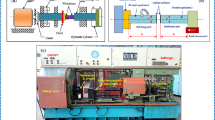Abstract
Mild steel offers a variety of properties for various applications at lower costs giving the alloy a large application base in industry. However, the increasing complexity and severity of service environments has shifted the focus of many industries to structure modification techniques, like heat treatment, to improve material properties and performance. The focus of this paper was to therefore investigate the effect of heat treatment induced hardness on the sliding wear behaviour of mild steel. The results showed that resistance to dry sliding wear increased with increasing hardness of the mild steel samples. Both abrasive and adhesive wear mechanisms were observed to occur on the samples, however abrasive wear was predominant.
Similar content being viewed by others
References
J. M. Dubois and E. Belin-Ferré, “Friction and solid-solid adhesion on complex metallic alloys,” Sci. Technol. Adv. Mater., vol. 15, no. 3, 2014.
M. O. A. Mokhtar, “The effect of hardness on the frictional behaviour of metals,” Wear, vol. 78, no. 3, pp. 297–304, 1982.
S. C. Bellemare, M. Dao, and S. Suresh, “Effects of mechanical properties and surface friction on elasto-plastic sliding contact,” Mech. Mater., vol. 40, no. 4–5, pp. 206–219, 2008.
I. A. Mohamed, A. A. Ibraheem, M. I. Khashaba, W. Y. Ali, and F. Engineering, “Influence of Heat Treatment on Friction and Wear of ductile Iron: I. Role of Copper and Molybdenum,” Int. J. Control. Autom. Syst., vol. 2, no. 3, 2013.
Y. Sahin, M. Erdogan, M. Erdogan and V. Kilicli, “Wear behavior of austempered ductile irons with dual matrix structures,” Materials Science and Engineering A, vol. 444, no. 1, pp. 31–38, 2006.
K. Kato, “Wear in relation to friction - A review,” Wear, vol. 241, no. 2, pp. 151–157, 2000.
G. Stachowiak and A. Batchelor, “12 Adhesion and Adhesive Wear,” in Engineering TriBology, Elsevier, 1993, pp. 613–635.
F. Puccio, “Biotribology of artificial hip joints”, World Journal of Orthopedics, vol. 6, no. 1, p. 77, 2015. Available: 10.5312/wjo.v6.i1.77 [Accessed 5 November 2019].
M. Singh, D. P. Mondal, O. P. Modi and A. K. Jha, “Two-body abrasive wear behaviour of aluminium alloy–sillimanite particle reinforced composite,” Wear, vol. 253, no. 3, pp. 357–368, 2002.
R. Attota, M. Surappa and A. Ravikiran, “Oscillations in coefficient of friction during dry sliding of A356 Al-30% WT SiCp MMC against steel,” Scripta Materialia, vol. 36, no. 1, 1997.
N. L. Parthasarathi, U. Borah and S. K. Albert, “Correlation between coefficient of friction and surface roughness in dry sliding wear of AISI 316L(N) stainless steel at elevated temperatures,” Computer Modelling and New Technologies, vol. 17, no. 1, p. 51–63, 2013.
R. R. Phiri and O. P. Oladijo, “Effect of Deposition Temperature on the Wear Behavior of WC-Co coated Mild Steel Substrate,” vol. 2019, no. June, pp. 4–7, 2019.
Author information
Authors and Affiliations
Rights and permissions
About this article
Cite this article
Lebudi, C.L., Phiri, R.R., Leso, T. et al. Effect of Heat Treatment Hardening on the Dry Sliding Wear Behaviour of Mild Steel. MRS Advances 5, 1195–1202 (2020). https://doi.org/10.1557/adv.2020.72
Published:
Issue Date:
DOI: https://doi.org/10.1557/adv.2020.72




